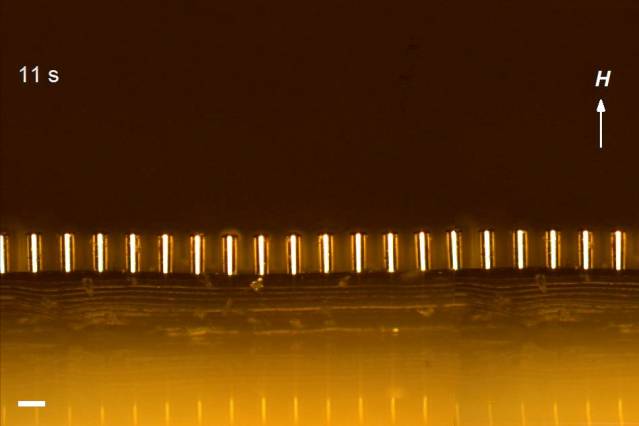New microhairs bend in magnetic field, directing water against gravity
August 11, 2014

The new material designed by MIT researchers is a flexible polymer “skin” coated with microhairs (white lines) that tilt in response to a magnetic field.
MIT engineers have fabricated a new elastic material coated with microscopic, hairlike structures that tilt in response to a magnetic field.
Depending on the field’s orientation, the microhairs can tilt to form a path through which fluid can flow; the material can even direct water upward, against gravity.
Each microhair, made of nickel, is about 70 microns high and 25 microns wide — about one-fourth the diameter of a human hair. The researchers fabricated an array of the microhairs onto an elastic, transparent layer of silicone.
MIT | MIT engineers have fabricated a new elastic material coated with microscopic, hairlike structures that tilt in response to a magnetic field. Depending on the field’s orientation, the microhairs can tilt to form a path through which fluid can flow; the material can even direct water upward, against gravity. Video produced and edited by Melanie Gonick/MIT News. Video clips courtesy of the researchers.
In experiments, the magnetically activated material directed not just the flow of fluid, but also light — much as window blinds tilt to filter the sun. Researchers say the work could lead to waterproofing and anti-glare applications, such as “smart windows” for buildings and cars.
“You could coat this on your car windshield to manipulate rain or sunlight,” says Yangying Zhu, a graduate student in MIT’s Department of Mechanical Engineering. “So you could filter how much solar radiation you want coming in, and also shed raindrops. This is an opportunity for the future.”
In the near term, the material could also be embedded in lab-on-a-chip devices to magnetically direct the flow of cells and other biological material through a diagnostic chip’s microchannels.
Zhu reports the details of the material this month in the journal Advanced Materials.
The inspiration for the microhair array comes partly from nature, Zhu says. For example, human nasal passages are lined with cilia — small hairs that sway back and forth to remove dust and other foreign particles. Zhu sought to engineer a dynamic, responsive material that mimics the motion of cilia.
In principle, more complex magnetic fields could be designed to create intricate tilting patterns throughout an array, say the researchers. Such patterns may be useful in directing cells through a microchip’s channels, or wicking moisture from a windshield. Since the material is flexible, it may even be woven into fabric to create rain-resistant clothing.
This research was supported by funding from the Air Force Office of Scientific Research.
Abstract of Advanced Materials paper
Magnetically tunable micropillar arrays with uniform, continuous and extreme tilt angles for real-time manipulation are reported. We experimentally show uniform tilt angles ranging from 0° to 57°, and develop a model to accurately capture the behavior. Furthermore, we demonstrate that the flexible uniform responsive microstructures (μFUR) can dynamically manipulate liquid spreading directionality, control fluid drag, and tune optical transmittance over a large range.